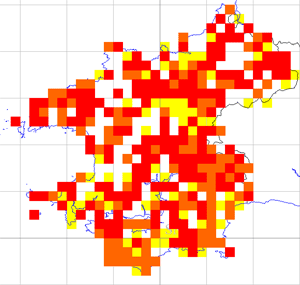The Pied Wagtail, sub- species yarrelli, breeds throughout Pembrokeshire.
In Pembrokeshire, Pied Wagtails utilise a wide range of nesting habitats, ranging from natural cavities, holes and recesses e.g. in rock faces or sea-cliffs, (pers. obs.) banks, old stone walls, buildings, e.g. out buildings, barns, sheds and even castles. Foraging habitats include the foreshore, saltmarsh, farmland, including farm yards and slurry pits, and urban environments.
The 1984-88 tetrad survey confirmed that the Pied Wagtail is a widespread breeding resident. It was found in most parts of the county, from the coastal fringes and offshore islands to the upper parts of the Preseli Hills. The map shows that by the 2003-07 tetrad survey, the distribution of breeding Pied Wagtails had become patchy, with gaps opening up in parts of mid-Pembrokeshire and areas such as the Pencaer Peninsula and Cemaes/Poppit/St. Dogmaels area. These localised losses appear to have been counter-balanced by breeding records obtained in the 2003-07 survey in tetrads where Pied Wagtails had not previously been recorded as confirmed or probable breeding.
The tetrad data indicate an overall increase in the number of tetrads where Pied Wagtails occur as a breeding species:
A 17.2% increase in the number of tetrads in which breeding was confirmed between the two tetrad surveys compares favourably with a 15% increase in the breeding population across the UK as a whole between 1994 and 2007 (data from the BBS survey).
Following the 1984-88 tetrad survey, the total breeding population of Pied Wagtails in the county was estimated to be between 1400 and 1700 pairs, based on an average density of 5-6 pairs per tetrad. On this basis the 2003-07 tetrad survey suggests an increase in the total breeding population, to perhaps 1,700 – 2,000 pairs.
Jane Hodges

Fieldwork 2003-07 (based on 490 tetrads)
Red = breeding confirmed = 192
Orange = breeding probable = 105
Yellow = breeding possible = 72
Total tetrads in which registered = 369 (75.3%)
 Saturday, December 14, 2019 at 8:25PM
Saturday, December 14, 2019 at 8:25PM  Pembrokeshire Avifauna committee | Comments Off |
Pembrokeshire Avifauna committee | Comments Off |  1994 BoP in
1994 BoP in  Pied/White Wagtail
Pied/White Wagtail 





